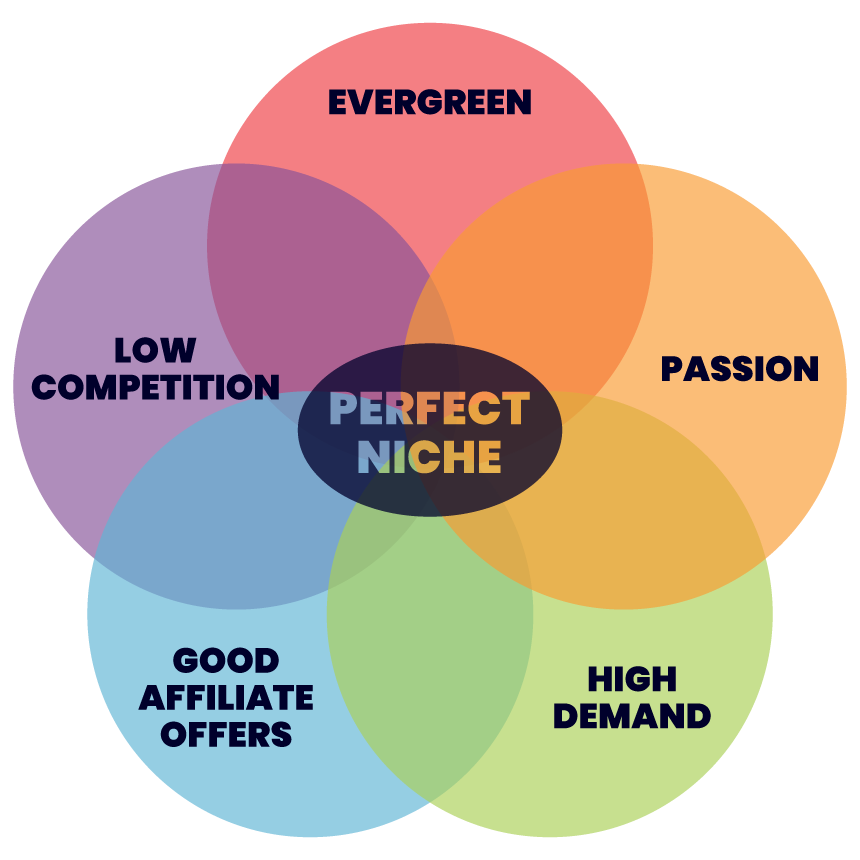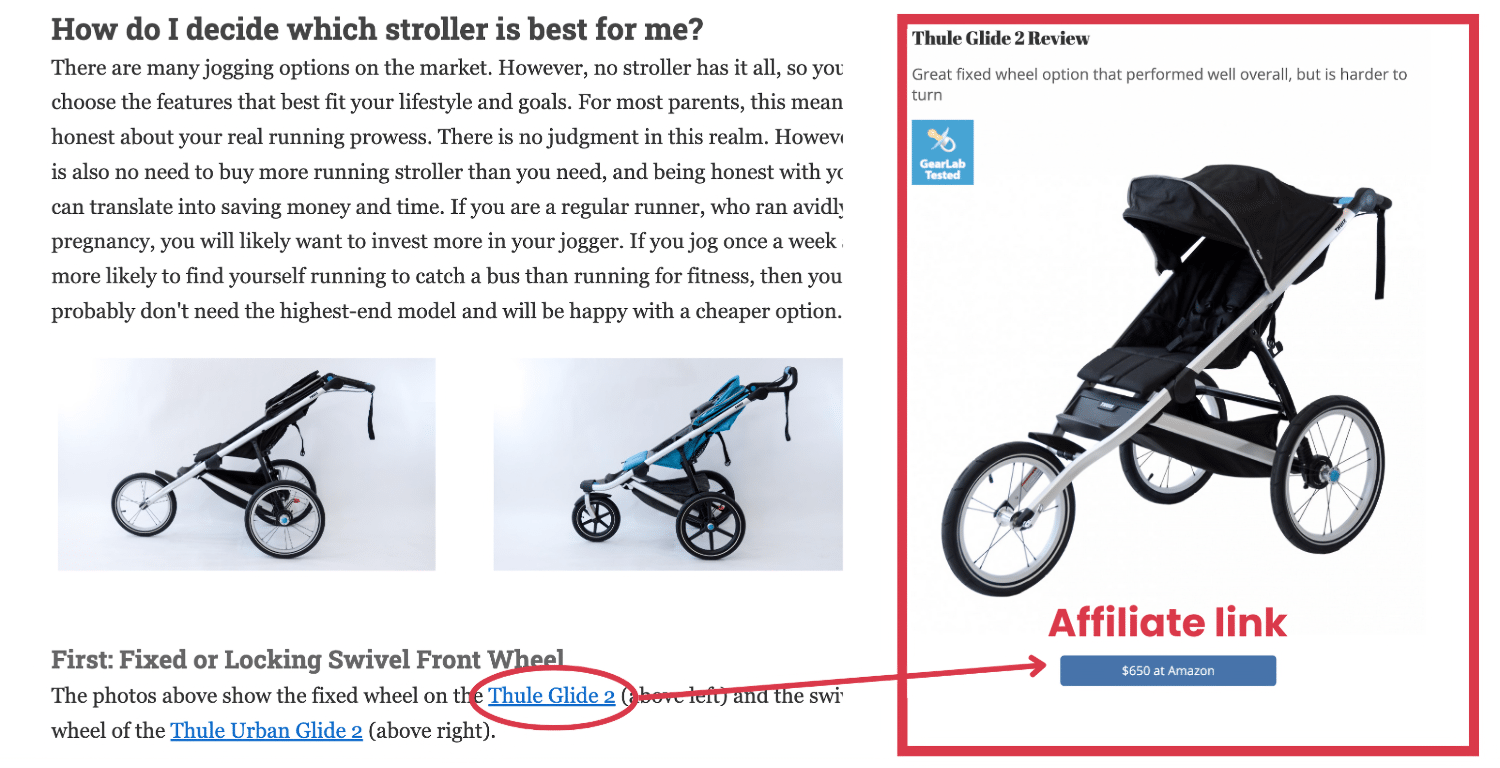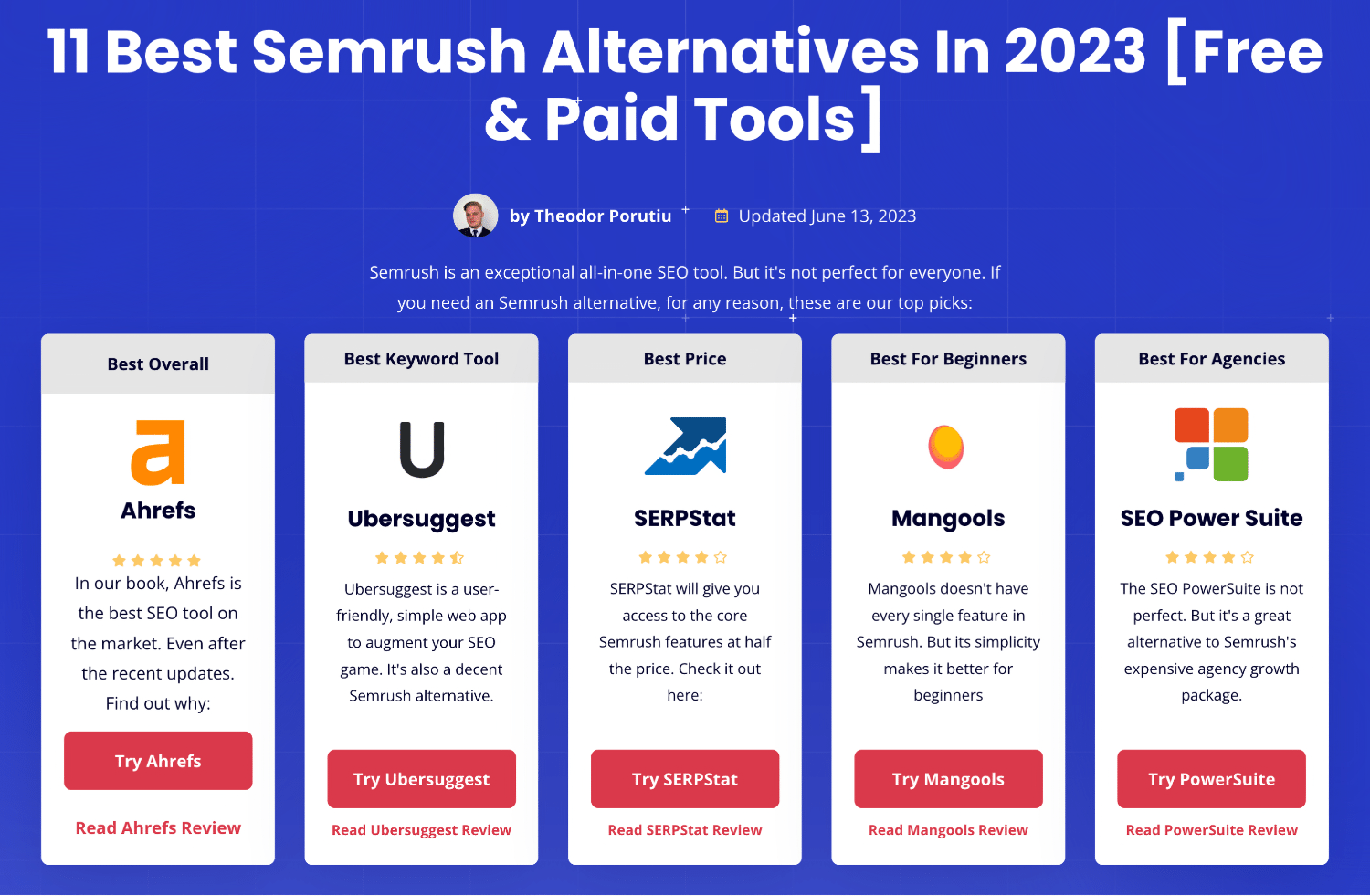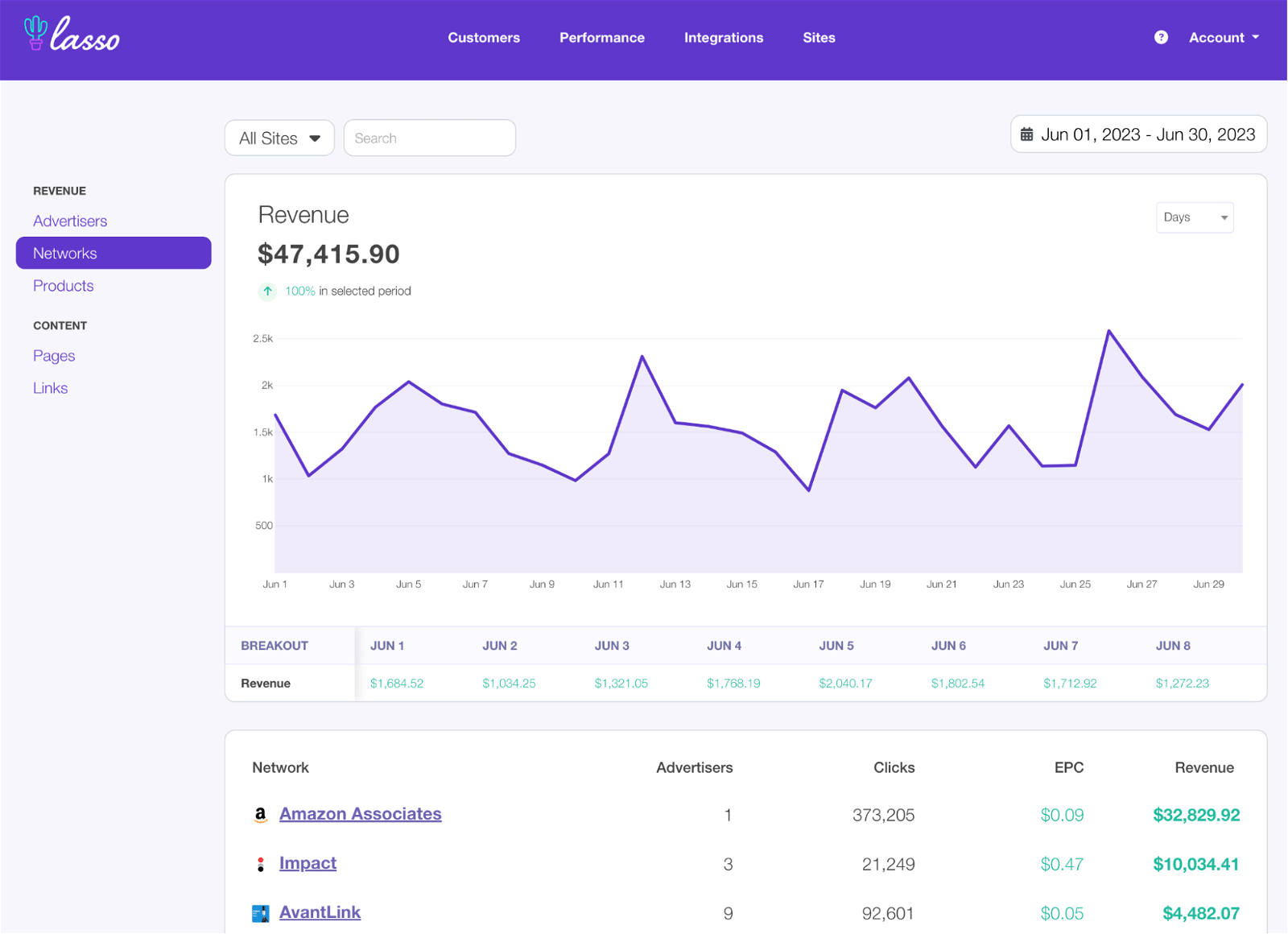If you want to learn how to start affiliate marketing, you’re in the right place.
We’ve built and sold three profitable, six-figure affiliate sites and guided over 15,000 students to achieve similar success.
Affiliate marketing is easy to get into. It doesn’t require much money to get started; you only need your laptop. But, most people find that it takes a lot more work than expected, and it can be tricky to compete against some of the bigger players in the industry.
In this article, we’ll summarize everything we’ve learned about making this work into a simple seven-step process you can follow.
How to Start Affiliate Marketing
Affiliate marketing is a way to earn money by promoting a company’s products or services through a unique affiliate link. When someone clicks on your link and takes an action, like making a purchase, you earn a commission.
It’s a win-win-win situation: the customer gets what they need, the brand makes a sale, and you earn money. As an affiliate marketer, you’ll join a program and get a custom affiliate link with a tracking ID. This helps the merchant track your referrals and make sure you get credit for any sales or leads.
There are seven steps to starting (and succeeding in affiliate marketing), which we’ll run through now:
- Choose A Profitable Niche That You’re Passionate About
- Build A Website (Or Platform) Where You Can Promote Your Products
- Join Relevant And Reputable Affiliate Programs Or Networks
- Create Valuable Content That Attracts And Educates Your Audience
- Add Your Affiliate Links Strategically To Your Content
- Drive Traffic To Your Website Or Platform
- Track And Optimize Your Affiliate Marketing Performance
1 Choose a Niche
A niche is a specific area of focus, such as fitness, finance, or fashion. It’s important to choose one because it helps you become a specialist, which means less competition and more trust from your audience.
Niching down can also improve your SEO, helping you narrow focus and build topical authority in Google’s eyes. The more defined your niche, the better, as it provides greater clarity and makes it easier to plan content and find products.
The best niches are ones you have strong knowledge of. You should also consider the competition, demand, and potential for monetization.

When picking your niche for affiliate marketing, make sure it meets the following criteria:
It remains relevant over time: Choose an evergreen niche where demand doesn’t fade. For example, credit repair is an evergreen niche because there will always be people looking to improve their credit scores. Meanwhile, the ski and snowboarding niche is more popular during winter.
It offers multiple high-paying affiliate programs. Ideally, you want more than one to protect against affiliate program changes. So, if fashion is your niche, don’t put all your eggs into Amazon’s basket.
It has high demand: Aim for a niche with thousands of monthly searches for its keywords, indicating high demand and an existing market to tap into.
It has low competition: Getting started in a niche with less competition is easier. Some competition is good, as it means money is likely to be made.
It aligns with your passion: Choose a niche that interests you. Your energy and dedication will make work more enjoyable and improve your chances of success.
It’s a top earner. When it comes to earning potential, not all niches are created equal. Check out our affiliate marketing statistics page to see which niches can earn the most money. However, a higher earnings ceiling can equal higher competition.
Some of the biggest affiliate sites have capitalized on their passion and expertise to corner a niche, such as RetroDodo (retro video games), Modest Man (fashion for short men), Epic Gardening (gardening — and it makes eight figures per year!).

Niching down can position you as an expert, allowing you to dive deep into a topic and build trust. It also helps with SEO (search engine optimization) by increasing your topical authority in Google’s eyes.
2 Build a Website
Affiliate marketing is one of the few businesses you can start with little to no money.
Affiliate marketing can be done without a website, but we recommend starting one. You can also promote affiliate products using various alternative channels, such as YouTube, social media, newsletters, and podcasts.
Starting a website these days is easy and affordable. The upfront cost for a domain name and hosting is just $2.98, and you’ll pay $1.99 per month (to run hosting) for the first year. We’d recommend using Brandsnap to find a suitable domain name and using Siteground (from $1.99) for hosting for your first website.
If you prefer other platforms to promote affiliate deals, weigh up your strengths:
If you’re good at writing long-form: start a website and/or email list
If you’re good at short-form content: start with Facebook, Twitter, or LinkedIn
If you’re good at photography: start with Instagram or Pinterest
If you’re a good conversationalist: start a podcast (a caveat here: the podcasting medium offers little opportunity to promote clickable affiliate links)
If you’re good at video: start a Tiktok or YouTube channel
3 Find Affiliate Programs
You need to join affiliate programs or networks to promote affiliate products and earn commissions. While a program is a direct partnership between you and a brand, a network is a hub for multiple programs under one roof.
Not all affiliate programs are created equally, though, and there are six key areas you should look at before you start promoting a product:
Commission rate: Look for competitive rates that maximize your earnings.
Cookie duration: This is the “window” that a visitor has to buy a product after they click on your affiliate link so that you still get a commission. Longer durations increase your chances of earning commissions.
Conversion rate: High commission rates aren’t everything. Finding high-converting products can be even more profitable. Amazon Associates is still a great affiliate program despite lower commission rates.
Earnings per click (EPC): This metric shows your affiliate links’ average earnings per click. Knowing how much you earn for each click, you can make informed decisions about which campaigns to focus on and optimize for maximum profitability.
Product quality: Promote products with a good brand reputation that are valuable and align with your audience’s interests. Look for reputable brands that customers recognize and trust.
Customer support: Opt for programs or networks with reliable support.
Accepting standard affiliate terms makes the most sense when you’re just starting. You can negotiate better terms once you’ve proven your success to brands.
For beginners, the Amazon Associates program is a great place to start. It has endless products and is available in most countries. As you gain traction, you can get set up on a few affiliate networks, such as:
Don’t just sign up to affiliate marketing programs and networks aimlessly. Rather, find your ideal partners first.
If you are already part of an affiliate network, you can easily find brands with programs on the network. To find suitable partners, search for specific brands (e.g., “Nike”) or keywords related to your industry (e.g., “sportswear”).
There may be brands you’d like to work with that are not affiliated with a network. Come up with a list of names and see if they already have an affiliate program you can join. A quick way to do this is to search for “[Brand] affiliate” on Google.
Most brands also include a link to their affiliate program details in their website footer, so when you’re on the site, use the shortcut Ctrl+S and “affiliate” to find their program page.
These pages usually direct you straight to a registration form where you can submit your application.
4 Create Content
Creating content is the key to bringing eyeballs to your affiliate offerings.
The platform you choose doesn’t really matter, but the content does—and it matters a lot. Without great, useful content, your affiliate marketing project will fail.
Informational: Informative articles, guides, and how-to tutorials related to your niche can help educate your audience while warming them up to buy.
Let’s look at BabyGearLab’s tutorial on choosing a jogging stroller. It has practical and technical considerations and links to product review pages. This is where they include affiliate links.

Reviews: People want to know whether the product is good before buying. Offer in-depth, honest assessments of specific products or services to give your audience insights and recommendations.
Baby Gear Lab rates the Thule Glide 2 stroller above on jogging-specific specs like run-ability and size.

Comparisons: Side-by-side product comparisons highlight their pros and cons, helping readers make informed decisions. They’re also great for people who want to scan for the key points. BabyGearLab weighs the specs of the best jogging strollers alongside each other.

Round-ups: Curated lists of the best products or services in a particular category. To round out its coverage of jogging strollers, BabyGearLab combines all the pieces in a top-six blog post.

The type of traffic you get will dictate the success of your affiliate conversions. Informational content (e.g., How to Choose a Jogging Stroller) doesn’t usually convert as well as product content (e.g., Top 6 Jogging Strollers) as the visitor arrives on the page with a different mindset.
But that’s not to say info content can’t work well for affiliates. Identifying users’ pain points and providing them with a clear solution (e.g., a product you’re promoting) can also convert well.
The key steps to creating valuable content for visitors include:
Identify Customer Pain Points: Understand your audience’s challenges and problems to effectively provide tailored solutions that address their needs.
Provide Solutions: Offer practical solutions and actionable advice to help your audience overcome obstacles or achieve their desired outcomes.
Differentiate Yourself: Stand out from other affiliates in your niche by offering unique content formats such as data-driven comparisons, video reviews, or real-life tests.
Build Trust: Be transparent, honest, and unbiased in your content. Your audience relies on your recommendations, so it’s important to establish trust and credibility.
Showcase Benefits: Highlight the benefits and unique selling points of the products or services you’re promoting. Explain how they can solve problems and improve the lives of your audience.
Trigger Emotions: Connect with your audience emotionally by sharing personal experiences, success stories, or relatable anecdotes.
Provide Solutions: Offer practical solutions and actionable advice to help your audience overcome obstacles or achieve their desired outcomes.
Inspire Action: Include clear calls to action in your content, guiding your audience to take the desired action, such as making a purchase or signing up for a service.
Discover the secrets to crafting compelling product reviews with our in-depth, step-by-step tutorial.
While it’s tempting to create commercial content for your affiliate website, you’ll actually want to create a mix of content types to serve your audience best (and show search engines that you’re a true authority in your niche).
What’s more, it’s much more likely that people and other websites will share and link to informational content, rather than commercial content.
5 Add Affiliate Links
Adding an affiliate link is easy, but executing it well is more nuanced. Too many links can hurt your credibility, SEO, user experience, and conversion rate. Moreover, sending people to a page when they’re not ready to buy is unlikely to result in a sale.
Ensure users know what they’re clicking on and where the link will go. Don’t mislead them into clicking on “a cute cat video,” which leads to an affiliate link for a sketchy product you’re promoting.
Instead, prime users’ expectations so they actively want to click on your affiliate link. Make the links clear (e.g. “Buy the thing here”) — whether a text link or a logically placed button.
While you don’t want to overload your page with buttons or links, don’t hesitate to offer multiple buy buttons from different stores. This can increase your trustworthiness, showing you’re not in bed with a single brand.
With certain types of content, users might look for the links immediately. For example, in product round-ups, they might open all the links simultaneously across multiple tabs. So, it can be effective to front-load your content with recommendations. This means giving product tips at the very start of the article. Standout product boxes or tables can also help. Tools like Lasso can help you do this.
Wirecutter is great at this, as you can see below.

This idea of front-loading your content doesn’t just apply to commercial content. It’s a great idea for any blog post you write. If you’ve got an answer or solution for the visitor’s query, give it to them straight away—don’t make them scroll through endless content to find it.
We do this on the Authority Hacker blog (as you can see below). We have an in-depth article on the best Semrush alternatives. Still, before you even start reading, you’ll be presented with the five best options, depending on your circumstances (e.g., Best Overall, Best Price, Best for Beginners, Best for Agencies).

6 Drive Traffic
You need to figure out how to drive visitors to your content so they can engage with your links.
Driving traffic is the biggest challenge of all. Not just for affiliates. For all businesses.
There are essentially two types of traffic: free and paid.
Paid traffic is basically adverts — places you’ll pay for your content to appear (e.g., Facebook Ads and Google Ads). However, the most appealing opportunity for any affiliate marketing business is free traffic.
Free traffic sources allow you to attract visitors to your content without any direct monetary cost. While they require time and effort, they can yield excellent long-term results. These opportunities can come from your content appearing in search engines, YouTube, social media, and your email list.
Examples of Free Traffic Sources:
Organic search (via SEO): Optimize your content to rank well in search engine results (primarily Google) and attract organic traffic to your affiliate offers.
YouTube: Create videos that are recommended to YouTube visitors by the platform’s algorithm and appear in search results on YouTube itself.
Social Media: Leverage platforms like Facebook, Twitter, Instagram, and LinkedIn to engage with your audience, share your content, and drive traffic to your website.
Email Marketing: Build an email list and send targeted newsletters or promotions to your subscribers, encouraging them to visit your website.
Guest Posting: Write and publish content on other websites or blogs within your niche, with a link back to your site, to tap into their audience and drive traffic.
Paid traffic sources come from investing money to drive targeted traffic to your website or platform. Paid traffic can provide faster results but requires careful planning and monitoring of your campaigns. It will eat into your profit margins even if you make it work.
Obviously, free traffic sources hold the greatest appeal because they’re, well… free. This is also the route we’d recommend focusing on in the long term for your affiliate marketing strategy.
7 Track and Optimize Performance
If you want to be successful at anything, you need to find what works and do more of it. Affiliate marketing is no different.
Unlike most traditional marketing campaigns, tracking your performance as an affiliate marketer is possible. That said, you’ll need to master a few tools (as we’ll discuss below) to understand how you earn every cent in your affiliate business.
On a website, you can track every visitor, every click, and every sale. To grow and scale, you need to understand which affiliate marketing efforts are working best and focus on these.
- Google Analytics: Provides insights into website traffic and user behavior to help affiliate marketers track key metrics and optimize their websites for better performance and conversions.
- Google Search Console: Helps website owners who focus on SEO monitor and optimize their site’s presence in Google search results, providing valuable information on search performance and website health.
While Google’s suite of tools is great for monitoring website and page performance, they cannot track affiliate sales and commissions.
However, with Lasso, you can track your affiliate performance to the exact cent. It’s a single dashboard that tracks clicks and revenue across advertisers, networks, and products. This makes it easy to monitor and optimize your affiliate marketing efforts.

You can identify which affiliate content performs best with tools like Google Analytics and Lasso Performance. This will help you plan for future content and optimize existing content (e.g., changing CTAs, button placement, and page design).
Best Affiliate Marketing Tools to Help Make Your First $1,000
If you’re ready to build an affiliate website, here are our recommended tools for beginners. Over time, you might want to upgrade these tools for more expensive fully-featured options — but for newbies, they’ll be more than enough to help you make your first $1,000 as an affiliate marketer
- SiteGround: The most affordable hosting to power your website. Plans are available from just $1.99.
- GeneratePress: Prevents the need to hire an expensive web designer to create a beautiful website. Use this drag-and-drop website builder instead.
- WP Rocket: Speeds up your website. Important for user experience and SEO.
- Ubersuggest: The most affordable keyword research tool around currently. Free version available.
- RankMath: Helps you get the SEO basics in place for every page on your website. Free version available.
- Mailerlite: The most affordable email marketing tool available. Make sure to collect email addresses as soon as you get decent traffic. Free version available.
- Google Analytics (and Search Console): Must-Haves for any website. Analytics tracks visitors on your website, while Search Console shows you what keywords visitors use to find you (and checks on the health of your website). Both are free.
Why Affiliate Marketing Is a Good Business Model
Thanks to its minimal upfront costs, affiliate marketing is a simple and low-risk business model. It’s common to see people starting a successful affiliate marketing business with practically nothing. And it’s easy to run from an operational standpoint.
Success stories like VPN Mentor, which fetched $150 million in 2021, demonstrate the potential earning power.
Even large media entities are getting involved in affiliate marketing to increase their profits. Take The Wirecutter, one of the most famous affiliate websites in the world.

It was sold to the New York Times for a cool $30 million in 2016. Seven- and eight-figure exits aren’t rare for affiliate websites. This is the magic of affiliate marketing: the opportunities are there for everybody.
How Much Can You Make From Affiliate Marketing
The amount of money you can make from affiliate marketing varies greatly, with some affiliates earning millions of dollars (such as Epic Gardening’s Kevin Espiritu) and others earning just enough to buy a candy bar.
As a beginner, you can earn anywhere from $0 to $1,000 per month, depending on several key factors that affect your earning potential.
To give you an idea, here are our estimations of how much you can make from affiliate marketing:
- Beginner: $0 to $1,000 per month
- Intermediate: $1,000 to $10,000 per month
- Advanced: $10,000 to $100,000 per month
- Expert: $100,000+ per month
These expert earnings are rare. But some, like Shane Dutka, a former accountant turned full-time digital entrepreneur through the Authority Hacker Pro community, bring in hefty five-figure incomes every month.
Many factors influence your affiliate marketing earning potential, such as:
Niche Choice: Niches like finance, health, and technology often yield higher profits due to their larger customer base and higher commission rates.
Commission Structure: Varies by brand and product type, with digital products often offering higher rates.
Traffic Quality and Quantity: High-quality, targeted traffic is key to affiliate success. Your platform needs to pull in relevant, interested visitors.
Conversion Factors: The value and optimization of your content, product value proposition, and audience trust all impact the conversion rate.
So, the answer to how much money affiliate marketers make is as definitive as trying to measure a piece of string. But if you’re prepared to experiment with strategy and take the time and effort to find the winning formula for you and your affiliate site, you can make some serious money.
Final thoughts…
Achieving passive income with affiliate marketing involves a lot of work. Expect some serious initial effort, experimentation, and refinement. But with these steps, you’re primed for your first affiliate sale.
Now that you’re equipped with the basics, take your skills up a notch with our free video training.
Join us to learn how to find profitable niches, build websites that rank, and plenty more.
Sign up for free today.
FAQs
It is possible to start affiliate marketing with no money. However, to become a successful affiliate marketer, you’ll need to invest time and/or money in learning the key principles and best practices of affiliate marketing.
You can start affiliate marketing with no upfront cost by growing an audience on social media platforms or YouTube channel.
Starting an affiliate marketing website can also be done for less than $5, but there are a lot of things you need to learn about affiliate marketing to make it really work.
Affiliate marketing has virtually no barrier to entry. Upfront costs are virtually zero, and anyone with an internet connection has access to all the tools they need.
However, affiliate marketing is highly competitive, therefore it’s very important to learn the fundamentals (see Authority Hacker’s free training) to stand a good chance of creating a successful affiliate marketing business.







